Video-Examples of Various Argentine Tango Moves
(German version)
Table of Contents
- 1. Introductory Remarks
- 2. Axis Instructions
- 3. Back-Turn-Step
- 4. Backward-Close-Forward
- 5. Barrida
- 6. Boleo
- 7. Change Of Weight
- 8. Colgada
- 9. Cross
- 9.1. Cross Instructions
- 9.2. Follower Direct Forward-Cross
- 9.3. Follower Indirect Forward-Cross
- 9.4. Follower Direct Backward-Cross
- 9.5. Follower Indirect Backward-Cross
- 9.6. Leader Direct Forward-Cross
- 9.7. Leader Indirect Forward-Cross
- 9.8. Leader Direct Backward-Cross
- 9.9. Leader Indirect Backward-Cross
- 10. Cunita
- 11. Decoration
- 12. Embrace
- 13. Enganche [see also Gancho, Piernazo, Pulpeada]
- 14. Enrosque
- 15. Expansion
- 16. Gancho [see also Engache, Piernazo, Pulpeada]
- 17. Kick
- 18. Lift (Figure)
- 19. Molinete
- 20. Ocho
- 21. Parada
- 22. Passada
- 23. Pendulum-Step
- 24. Piernazo [see also Engache, Gancho, Pulpeada]
- 25. Pivot
- 26. Pose
- 27. Projection
- 28. Promenade
- 29. Pulpeada [see also Engache, Gancho, Piernazo]
- 30. Punto
- 31. Rebote
- 32. Sacada
- 33. Sandwich
- 34. Skip
- 35. Small Fast Steps
- 36. Solo-Turn
- 37. Soltada
- 38. Split
- 39. Step-Over
- 40. Turn
- 41. Volcada
- 42. Walk
- 43. Weaver-Step
1. Introductory Remarks
This is a collection of video-examples of Argentine Tango moves I found on youtube. I find it instructive to see how they are actually danced by advanced dancers. That is often quite different from how they are taught. The examples also inspire me to try new moves myself. It would be great, if you, too, find the collection helpful and inspiring for learning Tango.
I recommend to use a flatrate internet connection, because the videos seem to be downloaded anew each time you klick on an example. No idea, why they are not stored in and reused from the cache.
The small images serve as a visual cue and are linked to the youtube videos at the right position, starting about 1 sec before the move in question. At the top you find the name of the dancers and the year when the video was uploaded. Below in red you see the type of music (Tango, Milonga, or Vals) or the language of instruction (English, German, or silence). On the right is given the youtube video ID and the exact time of the move (in the format min:sec.millisec), which can help you jump back to the start of the move, if you want to see it multiple times. At the bottom you see in red the name of the move, and possibly in black above and below the red line the move before and after the main move, respectively. Leaders and followers are indicated by 'x>' and 'o>'. Sometimes you see an additional '3x' or 'Xx', which means three-times or multiple-times. A red frame indicates tutorial videos. The faint images point to example that I find hard to see or redundant, or that follow related example so soon that one usually watches them in one go in any case. I thus recommend to skip them in a first round.
The original collection is written and maintained in German. The descriptions used for the moves are translated from German to English by a program I have written that simply substitutes German by English terms. The descriptions may therefore sound a bit awkward at times, or there might even be a German word left over, because I forgot to add a substitution rule. Maintaining a full English version in addition to the German version is just too much work and error prone.
For copyright reasons I am generally not permitted to show single images from the video as thumbnails. I therefore use the more abstract patterns. They shall help finding videos again you have seen before.
For some videos I have the explicit permission to use thumbnails. These are marked with "© Std. YT. Lic., w. perm." meaning "© Standard YouTube License, with permission from the copyrigth holder".
For their permission to use their material here on my web-page I do thank:
- Chiara Costa & Giovanni Perego (Tango de Arrabal), YouTube Channel UCDTydJfipFx4fIkwcH0AVcw
- Ricardo Lang & Raquel Lang (Tango Argentino Köln), YouTube Channel UCHlOM4NDAH0hHM3IyNyrnOA
- Catalina (Tangomeet), YouTube Channel UC4q0ayysWhe1ylyetwsYYBw
- Vanessa Gauch (http://www.vanessagauch.com/), YouTube Channel UC8VljvxJBzknk_j0vTIyDtA
- Homer & Christina Ladas, Class Notes tangostudent.blogspot.com, YouTube Channel @HomerLadas and @tangostudent
This collection currently contains 82 video instructions and 629 video examples.
5. Barrida
Barrida, also called sweep or drag, is a figure where one foot accompanies the foot of the partner such that it looks like a sweep or drag. I distinguish three variants and use the following terms:
- Sweep The foot of the leader seems to push the foot of the follower across the floor.
- Drag The foot of the leader seems to pull the foot of the follower across the floor.
- Lift The foot of the leader seems to carry the foot of the follower through the air.
I write 'seems' because in my oppinion the lead comes from the body and not the foot.
From the literal translations of the Spanish terms I find it natural to take Barrida for the sweep, Arrastre for the drag und Llevada for the lift. But I have not found evidence for that on YouTube. Barrida and Arrastre seem to be used interchangeably, ast least in English and German. Llevada is rarely being used.
| spanisch | deutsch | englisch | Bild | Definition | Quelle |
|---|---|---|---|---|---|
| el arrastre (m noun) | das Mitziehen | dragging | Leo, SpanishDict | ||
| Arrastre | From arrastrar - to drag. See Barrida. | (http://www.tejastango.com/terminology.html ) | |||
| barrer (verb) | fegen | to sweep | Leo, SpanishDict | ||
| barrida (? noun) | ? | sweep | Leo, SpanishDict | ||
| Barrida | Schieber | von - barrer - schieben, fegen Der Mann schiebt den Fuß der Dame und platziert ihn ohne den Kontakt zu verlieren. Barridas werden entweder von der Innen- oder Außenseite des Fußes der Partnerin angesetzt. Tipp: Die Führung und das Sich-Führen-Lassen kommt nicht aus den Füßen, sondern vom Körper. Die Argentinier lieben Fußball und Tango - bloß nicht zusammen. |
(https://www.tangoschokolade.de/tango-allgemein/73-tangoglossar ) | ||
| Barrida | „Feger” | fegende Bewegung; der Fuß des Partners wird mit dem eigenen Fuß bewegt | (http://tango-lugo.de/tango-argentino-in-muenchen/tango-lexikon ) | ||
| barrida, la | Das Fegen | Den Fuß des Partners aktiv mit dem eigenen Fuß wegschieben. | (http://www.tangosueno.de/index.php/tango-glossar.html ) | ||
| barrida (a) barrer | fegen, kehren eine fegende Bewegung Ein Fuß des Partners schiebt den anderen Fuß mit und lässt ihn dann frei weiter fliegen. Barridas werden sowohl von dem äußeren als auch von dem inneren Fuss der Tanzpartner ausgeführt. Siehe auch > Arrastre und > Llevada |
(http://www.sentimiento.de/Tango/Lexi.htm ) | |||
| Barrida | A sweep | a sweeping motion: One partner’s foot sweeps the other’s foot and places it without losing contact. Barridas are done from either the outside or the inside of the foot of the receiving party. The technique is different for the inside and outside barridas. See Arrastre and Llevada. | (http://www.tejastango.com/terminology.html ) | ||
| Barrida (arrastre) | Dragging |  |
One partner sweeps the others foot by displacing it along the floor. | (https://en.wikipedia.org/wiki/Figures_of_Argentine_tango ) Bild: (Piotr Cirrus, 2011, Wikimedia) © CC BY-SA 3.0 |
|
| la bicicleta (f noun) | das Fahrrad | bicycle | Leo, SpanishDict | ||
| Bicicleta | Bicycle: A circular movement of the feet led by the man in the vertical plane with the couples feet pressed together as in a barrida. | (http://www.tejastango.com/terminology.html ) | |||
| Bicicleta | Pedaling |  |
Movement which resembles pedaling on a bicycle. Induced by the leader placing his foot under or to the side of the follower's foot and lifting and lowering it. | (https://en.wikipedia.org/wiki/Figures_of_Argentine_tango ) Bild: (Piotr Cirrus, 2011, Wikimedia) © CC BY-SA 3.0 |
|
| el empujón (m noun) | der Schubs, der Stoß | push | Leo, SpanishDict | ||
| Empujadita | Small push |  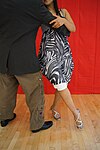 |
Displacement of the follower's leg by the leader's leg. | (https://en.wikipedia.org/wiki/Figures_of_Argentine_tango ) Bild 1: (Piotr Cirrus, 2011, Wikimedia) © CC BY-SA 3.0 Bild 2: (Piotr Cirrus, 2011, Wikimedia) © CC BY-SA 3.0 |
|
| llevar (verb) | tragen, mitführen | to take, to carry | Leo, SpanishDict | ||
| la llevada (f noun) | der Übertrag (elec.) | carriage | Leo, SpanishDict | ||
| Llevada | From llevar - to transport; a carry; to take with: Occurs when the man uses the upper thigh or foot to “carry” the lady’s leg to the next step. Barridas interspersed with walking steps in which the man takes the lady with him across the floor. | (http://www.tejastango.com/terminology.html ) |
6. Boleo
| spanisch | deutsch | englisch | Bild | Definition | Quelle |
|---|---|---|---|---|---|
| voleo | Volley(ball) | volley | PONS: spanisch - deutsch, SpanishDict | ||
| Voleo | See Boleo. | (http://www.tejastango.com/terminology.html ) | |||
| bolear (verb) | (zu)werfen, schleudern | to throw | PONS: spanisch - deutsch, SpanishDict | ||
| boleo (? noun) | throwing | PONS: spanisch - deutsch, SpanishDict | |||
| adelante | vor, vorwärts | forward | Leo, SpanishDict | ||
| Boleo / Voleo adelante | Front boleo |  |
Sharp movement of the leg often interrupted or suspended. The woman's lifts her foot from the floor and it flies to the side and wraps around her standing leg in front of her knee; boleos can be high (alto) or low (bajo). This move is alternatively named boleo and voleo in Spanish. | (https://en.wikipedia.org/wiki/Figures_of_Argentine_tango ) Bild: (Piotr Cirrus, 2011, Wikimedia) © CC BY-SA 3.0 |
|
| atrás | nach hinten, zurück | backward | Leo, SpanishDict | ||
| Boleo / Voleo atrás | Back boleo |  |
Sharp movement of the leg often interrupted or suspended initiated typically from a back ocho. The woman's foot lifts from the floor and it flies to the side and wraps around her standing leg at the back of the knee. This move is alternatively named boleo and voleo in Spanish. | (https://en.wikipedia.org/wiki/Figures_of_Argentine_tango ) Bild: (Piotr Cirrus, 2011, Wikimedia) © CC BY-SA 3.0 |
|
| en linea recta | geradeaus | Leo | |||
| linea (f noun) | Linie | line | Leo, SpanishDict | ||
| Boleo / Voleo en linea | Linear voleo |  |
Linear movement resulting in the leg's suspension in the air at the back of (typically) her body. | (https://en.wikipedia.org/wiki/Figures_of_Argentine_tango ) Bild: (Piotr Cirrus, 2011, Wikimedia) © CC BY-SA 3.0 |
|
| Boleo / Voleo | Boleo shapes |    |
Variants of boleo shape; low and high boleo; linear and circular boleo. | (https://en.wikipedia.org/wiki/Figures_of_Argentine_tango ) Bild 1: (Piotr Cirrus, 2011, Wikimedia) © CC BY-SA 3.0 Bild 2: (Piotr Cirrus, 2011, Wikimedia) © CC BY-SA 3.0 Bild 3: (Piotr Cirrus, 2011, Wikimedia) © CC BY-SA 3.0 |
|
| Boleo | From bolear - To throw: a boleo may be executed either high or low. Keeping the knees together, with one leg back, swivel and return on the supporting leg with a whipping action of the working leg. Sometimes spelled Voleo. See Latigazo. | (http://www.tejastango.com/terminology.html ) | |||
| latigazo (m noun) | Peitschenhieb | crack of the whip | PONS: spanisch - deutsch, SpanishDict | ||
| Latigazo | Whipping. Describes a whipping action of the leg as in a boleo. | (http://www.tejastango.com/terminology.html ) | |||
| látigo (m noun) | Peitsche | whip | PONS: spanisch - deutsch, SpanishDict | ||
| Latigo | The whip; also used to describe the whipping action of the leg in boleos to front or back, when led with energy and speed. See Latigazo and Boleo. | (http://www.tejastango.com/terminology.html ) | |||
| cuatro (m noun) | Vier | four | PONS: spanisch - deutsch, SpanishDict | ||
| Cuatro | A figure created when the lady flicks her lower leg up the outside of the opposite leg, keeping her knees together, and briefly creating a numeral 4 in profile. This can be led with a sacada or with an arrested rotational lead like a boleo, or it can be used, at the lady’s discretion, in place of a gancho or as an adornment after a gancho. See Amague. | (http://www.tejastango.com/terminology.html ) |
8. Colgada
| spanisch | deutsch | englisch | Bild | Definition | Quelle |
|---|---|---|---|---|---|
| colgada (adj) | aufgehängt | hanging | PONS: spanisch - deutsch, SpanishDict | ||
| Colgada | Colgada shapes |   |
Variants of colgadas shape – hip under, straight, and exaggerated "hip under". | (https://en.wikipedia.org/wiki/Figures_of_Argentine_tango ) Bild 1: (Piotr Cirrus, 2011, Wikimedia) © CC BY-SA 3.0 Bild 2: (Piotr Cirrus, 2011, Wikimedia) © CC BY-SA 3.0 |
|
| Colgada | A spinning move executed by a couple at the end of an inside barrida in which both dancers lean out away from each other and spin rapidly until the man leads out with a back step. | (http://www.tejastango.com/terminology.html ) | |||
| Colgada | Colgada |  |
(Off-axis) Position in which both partners are leaning back, may vary in degree of the tilt and body shape (see colgada shapes). Many fluid and elegant tango figures can be danced in colgada position. | (https://en.wikipedia.org/wiki/Figures_of_Argentine_tango ) Bild: (Piotr Cirrus, 2011, Wikimedia) © CC BY-SA 3.0 |
|
| Colgada | Colgada |   |
Off-axis move in which woman leans back while being supported by leader's arms. Simple colgadas can be executed during woman's step over leader foot. For variants see colgada shapes: hip-under colgada (picture on the left) describes colgada with woman hips under her rib cage; plank or straight colgada (picture on the right) is when her back tilt is without pronounced bend. | (https://en.wikipedia.org/wiki/Figures_of_Argentine_tango ) Bild 1: (Piotr Cirrus, 2011, Wikimedia) © CC BY-SA 3.0 Bild 2: (Piotr Cirrus, 2011, Wikimedia) © CC BY-SA 3.0 |
|
| Colgada | Step over colgada |  |
Off-axis move in which woman leans back while being supported by leader's arms. Simple colgadas can be executed during woman's step over leader foot. | (https://en.wikipedia.org/wiki/Figures_of_Argentine_tango ) Bild: (Piotr Cirrus, 2011, Wikimedia) © CC BY-SA 3.0 |
|
| Colgada | Side colgada |  |
Off-axis move in which woman leans to the side while being supported by leader's arms. | (https://en.wikipedia.org/wiki/Figures_of_Argentine_tango ) Bild: (Piotr Cirrus, 2011, Wikimedia) © CC BY-SA 3.0 |
9. Cross
| spanisch | deutsch | englisch | Bild | Definition | Quelle |
|---|---|---|---|---|---|
| contrapaso (noun) | ? | backstep, counterpace | Leo, SpanishDict | ||
| Contrapaso | A step produced when you lock one foot behind the other. For instance right foot steps forward, left foot locks behind right. Now right foot steps forward again. This can be done in single or double time, in one instance or repetitively. Also see Rabona and Traspie. | (http://www.tejastango.com/terminology.html ) | |||
| el cruce (m noun) | die Kreuzung, das Kreuzen | crossing, intersection | Leo, SpanishDict | ||
| cinco (noun) | die Fünf | five | Leo, SpanishDict | ||
| Cruce (cinco) | Cross (regular cross, position five) |  |
Crossed left foot in front of the right foot. See also Position 5. | (https://en.wikipedia.org/wiki/Figures_of_Argentine_tango ) Bild: (Piotr Cirrus, 2011, Wikimedia) © CC BY-SA 3.0 |
|
| adelante | vor, vorwärts | forward | Leo, SpanishDict | ||
| Cruce adelante | Front cross | see cross | Crossed one leg in front of the other | (https://en.wikipedia.org/wiki/Figures_of_Argentine_tango ) | |
| atrás | nach hinten, zurück | backward | Leo, SpanishDict | ||
| Cruce atrás | Back cross | see cross | Crossed one leg in back of the other | (https://en.wikipedia.org/wiki/Figures_of_Argentine_tango ) | |
| forzado (adj) | erzwungen | forced | Leo, SpanishDict | ||
| Cruce forzado | Forced cross | Crossed legs – induced by the lead. | (https://en.wikipedia.org/wiki/Figures_of_Argentine_tango ) | ||
| Cruzada | the cross | From cruzar - to cross; A cruzada occurs any time a foot is crossed in front of or in back of the other. The lady’s position at 5 of the 8-count basic. May also be called Trabada. | (http://www.tejastango.com/terminology.html ) | ||
| cruze de la mujer, el | Das Kreuzen der Frau | Kreuzen des rechten Fuß der Frau vor ihren linken Fuß, Schritt 5 des paso basico. Auch als Verb gebraucht: cruzar = kreuzen. |
(http://www.tangosueno.de/index.php/tango-glossar.html ) | ||
| Milonguero Cross | A step in which the man leads the lady to step side left around him, reverses before she completes the step, and leads her back into the cross. Also known as ochos cortados. | (http://www.tejastango.com/terminology.html ) | |||
| Ocho Cortado | Cut eight: change of direction: Occurs when a molinete or an ocho-like movement is stopped and sent back upon itself. Typical in club-style tango where many such brakes are used to avoid collisions. Describes a movement done on either foot, pivoting forward of backward, and going either left or right. | (http://www.tejastango.com/terminology.html ) | |||
| Rabona | A walking step with a syncopated cross. Done forward or backward the dancer steps on a beat, quickly closes the other foot in cruzada, and steps again on the next beat. Adapted from soccer. See Contrapaso and Traspie. | (http://www.tejastango.com/terminology.html ) | |||
| sobrepaso, el | Der Zwischenschritt | 1.: Älterer Begriff für das Kreuz der Frau (cruze de la mujer). [C. A. Estévaz (Petroloeo), Bol. d. Tango, Nr 21], [M. Pugliese, Bol. d. Tango Nr. 15] 2.: Kleine Zwischenschritte, die der Mann in doppelter Geschwindigkeit, die Schritte der Frau untermalend, ausführt. Häufig in der Milonga. |
(http://www.tangosueno.de/index.php/tango-glossar.html ) | ||
| Trabada | Another term for cruzada. | (http://www.tejastango.com/terminology.html ) | |||
| Traspie | Cross foot; triple step: A walking step with a syncopated cross. Using two beats of music the dancer does step-cross-step beginning with either foot and moving in any direction. See Contrapaso and Rabona. | (http://www.tejastango.com/terminology.html ) |
11. Decoration
| spanisch | deutsch | englisch | Bild | Definition | Quelle |
|---|---|---|---|---|---|
| Adorno | Adornment; embellishment. See Firulete. | (http://www.tejastango.com/terminology.html ) | |||
| Agujas | Needles: An adornment for the man done with the working foot vertical with the toe into the floor while pivoting inside a molinete. | (http://www.tejastango.com/terminology.html ) | |||
| Agujas | Needle |  |
Pointing foot towards the floor. | (https://en.wikipedia.org/wiki/Figures_of_Argentine_tango ) Bild: (Piotr Cirrus, 2011, Wikimedia) © CC BY-SA 3.0 |
|
| Amague | (from amagar - to make a threatening motion) a feint: An amague is used as an embellishment either led or done on one’s own, and may be used before taking a step. An example of an amague may be a beat (frappé) before taking a step. See Cuatro. | (http://www.tejastango.com/terminology.html ) | |||
| Amagues | Amagues |  |
A kick by one foot across in front of the other. May be very small high. | (https://en.wikipedia.org/wiki/Figures_of_Argentine_tango ) Bild: (Piotr Cirrus, 2011, Wikimedia) © CC BY-SA 3.0 |
|
| Caricias | Caresses: A gentle stroking with the leg or shoe against some part of the partner's body. They can be subtle or extravagant. See Adorno, Firulete, and Lustrada. | (http://www.tejastango.com/terminology.html ) | |||
| Caricias | Caresses |  |
Term describing caress like rubbing thigh, calf, or foot down the follower's body or leader's leg | (https://en.wikipedia.org/wiki/Figures_of_Argentine_tango ) Bild: (Piotr Cirrus, 2011, Wikimedia) © CC BY-SA 3.0 |
|
| Castigada | (from castigar - to punish) a punishment: A lofting of the lady's working leg followed by flexing at the knee and caressing the working foot down the outside of the supporting leg. Often done as an adorno prior to stepping forward, as in parada or in ochos. | (http://www.tejastango.com/terminology.html ) | |||
| Chiche | (pl. chiches) Small ornamental beats done around the supporting foot with the working foot in time with the music, either in front or in back as desired. See Adorno, Firulete. | (http://www.tejastango.com/terminology.html ) | |||
| Cuatro | Number four | 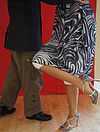 |
The follower's adornment formed when she crosses and raises her leg in front of the other leg. | (https://en.wikipedia.org/wiki/Figures_of_Argentine_tango ) Bild: (Piotr Cirrus, 2011, Wikimedia) © CC BY-SA 3.0 |
|
| Cuatro | A figure created when the lady flicks her lower leg up the outside of the opposite leg, keeping her knees together, and briefly creating a numeral 4 in profile. This can be led with a sacada or with an arrested rotational lead like a boleo, or it can be used, at the lady’s discretion, in place of a gancho or as an adornment after a gancho. See Amague. | (http://www.tejastango.com/terminology.html ) | |||
| Dibujo | Drawing; sketch: A dibujo is done by drawing circles or other small movements on the floor with one’s toe. See Firulete, Lapiz and Rulo. | (http://www.tejastango.com/terminology.html ) | |||
| Fanfarron | A rhythmic tapping or stomping of the foot in time with the music for dramatic and emotional effect. Boisterous behavior. See Golpecitos. | (http://www.tejastango.com/terminology.html ) | |||
| Firulete | An adornment; a decoration; an embellishment: Complicated or syncopated movements which the dancer uses to demonstrate their skill and to interpret the music. See Adorno and Lapiz. | (http://www.tejastango.com/terminology.html ) | |||
| Golpecitos | Little toe taps: Rhythmic tapping done with a flat foot on the ball or underside of the toe as an adorno. See Fanfarron and Zapatazo. | (http://www.tejastango.com/terminology.html ) | |||
| Golpes | Toe taps: With a tilted foot tap the floor with the toe and allow the lower leg to rebound keeping the knees together. See Picados and Punteo. | (http://www.tejastango.com/terminology.html ) | |||
| Lapiz | Pencil: Tracing of circular motions on the floor with the toe or inside edge of the working foot, while turning or waiting on the supporting foot. These may vary from small adornments done while marking time to large sweeping arcs which precede the lady as she moves around the man in molinete. See Dibujo, Firulete and Rulo. | (http://www.tejastango.com/terminology.html ) | |||
| Lapiz | Lapiz (pencil) |  |
Leader is pivoting with his leg extended and foot and toes pointing towards floor. | (https://en.wikipedia.org/wiki/Figures_of_Argentine_tango ) Bild: (Piotr Cirrus, 2011, Wikimedia) © CC BY-SA 3.0 |
|
| Lustrada | Polishing (shoe shine) |  |
Rubbing shoe or foot up and down partner's pants or leg. | (https://en.wikipedia.org/wiki/Figures_of_Argentine_tango ) Bild: (Piotr Cirrus, 2011, Wikimedia) © CC BY-SA 3.0 |
|
| Lustrada | From lustrar - to shine or polish; the shoe shine: A stroking of the man’s pant leg with a shoe. May be done by the lady or by the man to himself but is never done to the lady. | (http://www.tejastango.com/terminology.html ) | |||
| Picados | A flicking upward of the heel when turning or stepping forward. Usually done as an advanced embellishment to ochos or when walking forward. See Golpes. | (http://www.tejastango.com/terminology.html ) | |||
| Punteo | Point; with the point; peck: Rhythmic toe taps to the floor done with the toe, or point, of the shoe while the foot is moving over the floor in a sweeping movement as in boleo or planeo. See Golpes. | (http://www.tejastango.com/terminology.html ) | |||
| Planeo | Planeo |  |
Pivoting on one leg with the other leg stretched out. | (https://en.wikipedia.org/wiki/Figures_of_Argentine_tango ) Bild: (Piotr Cirrus, 2011, Wikimedia) © CC BY-SA 3.0 |
|
| Rulo | A curl: Used frequently at the end of molinete when the man, executing a lapiz or firulete ahead of the lady, curls his foot in around the lady and extends it quickly to touch the her foot. An older term for lapiz. | (http://www.tejastango.com/terminology.html ) | |||
| Toque | Touch | Short touch of the leader's instep by the follower's foot. (see also golpecitos) | (https://en.wikipedia.org/wiki/Figures_of_Argentine_tango ) | ||
| Zapatazo | Shoe taps: A dancer taps their own shoes together. See Adorno, Fanfarron, and Golpecitos. | (http://www.tejastango.com/terminology.html ) | |||
| Taps |  |
Quick taps done between steps or during a pause. Can be done by leader or follower. | (https://en.wikipedia.org/wiki/Figures_of_Argentine_tango ) Bild: (Piotr Cirrus, 2011, Wikimedia) © CC BY-SA 3.0 |
||
| Stork | See Calesita. Not used often or much recommended but refers to a position of the lady where the working leg is held with the lower leg lifted and horizontal in a figure four, or cuatro, position. | (http://www.tejastango.com/terminology.html ) |
12. Embrace
| spanisch | deutsch | englisch | Bild | Definition | Quelle |
|---|---|---|---|---|---|
| Abrazo | The embrace; a hug; or dance position. | (http://www.tejastango.com/terminology.html ) | |||
| Abrazo cerrado | V-shape close embrace | 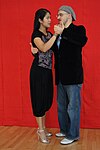  |
(Salon and tango nuevo) The dancers' chests are closer to each other than their hips, and often there is contact at about the level of the chest (the contact point differing, depending on the height of the leader and the closeness of the embrace). In close embrace, the leader and the follower's chests are in contact and they are dancing with their heads touching or very near each other. | (https://en.wikipedia.org/wiki/Figures_of_Argentine_tango ) Bild 1: (Piotr Cirrus, 2011, Wikimedia) © CC BY-SA 3.0 Bild 1: (Piotr Cirrus, 2011, Wikimedia) © CC BY-SA 3.0 |
|
| Abrazo abierto | Open embrace |   |
(Tango nuevo, salon) In open embrace, there can be as much space as desired between the partners, but there should always be complete contact along the embracing arms to give optimum communication. Argentine tango dancers do not hold their upper bodies arched away from each other; each partner is over their own axis. Whether open or closed, a tango embrace is not rigid, but relaxed, like a hug. | (https://en.wikipedia.org/wiki/Figures_of_Argentine_tango ) Bild 1: (Piotr Cirrus, 2011, Wikimedia) © CC BY-SA 3.0 Bild 2: (Piotr Cirrus, 2011, Wikimedia) © CC BY-SA 3.0 |
|
| Apilado (estilo milonguero, estilo del centro [de Buenos Aires]) | Square close embrace | 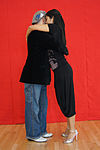  |
(Style milonguero) Milonguero style of embrace is danced in closed position, chest-to-chest, with the partners leaning – or appearing to lean – slightly toward each other to allow space for the feet to move. The follower's left arm position on the leader's shoulder is a style issue. It originates and is used in crowded milongas where there is so much people that you're literally dancing in "square". In those places the lifted arm avoids touching and accidentally hurting other people during turns. Close embrace, no V-shape. | (https://en.wikipedia.org/wiki/Figures_of_Argentine_tango ) Bild 1: (Piotr Cirrus, 2011, Wikimedia) © CC BY-SA 3.0 Bild 2: (Piotr Cirrus, 2011, Wikimedia) © CC BY-SA 3.0 |
|
| Tango al reves, doble frente | Reverse embrace | 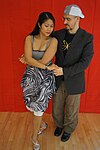  |
(Tango salon and nuevo) Reverse embrace where both partners face the same direction; it is now used only occasionally to perform tango figures (see doble frente). | (https://en.wikipedia.org/wiki/Figures_of_Argentine_tango ) Bild 1: (Piotr Cirrus, 2011, Wikimedia) © CC BY-SA 3.0 Bild 2: (Piotr Cirrus, 2011, Wikimedia) © CC BY-SA 3.0 |
|
| Pareja tomada | Practice embrace |  |
Both holding arms in practice position. | (https://en.wikipedia.org/wiki/Figures_of_Argentine_tango ) Bild: (Piotr Cirrus, 2011, Wikimedia) © CC BY-SA 3.0 |
|
| Pareja tomada | Practice embrace |  |
She holds his arms in practice position. | (https://en.wikipedia.org/wiki/Figures_of_Argentine_tango ) Bild: (Piotr Cirrus, 2011, Wikimedia) © CC BY-SA 3.0 |
|
| Pareja tomada | Practice embrace |  |
Holding him in "tea kettle" position. | (https://en.wikipedia.org/wiki/Figures_of_Argentine_tango ) Bild: (Piotr Cirrus, 2011, Wikimedia) © CC BY-SA 3.0 |
|
| Pareja tomada | Practice embrace |  |
Holding each other. | (https://en.wikipedia.org/wiki/Figures_of_Argentine_tango ) Bild: (Piotr Cirrus, 2011, Wikimedia) © CC BY-SA 3.0 |
|
| Doble frente | Moving together in one direction. |  |
The woman is in front of the man (see tango al reves style). | (https://en.wikipedia.org/wiki/Figures_of_Argentine_tango ) Bild: (Piotr Cirrus, 2011, Wikimedia) © CC BY-SA 3.0 |
13. Enganche [see also Gancho, Piernazo, Pulpeada]
| spanisch | deutsch | englisch | Bild | Definition | Quelle |
|---|---|---|---|---|---|
| engancharse (verb) | hängenbleiben | to get hooked | Leo, SpanishDict | ||
| el enganche (m noun) | (Anhänger-)Kupplung | coupling, hitching up, hook | Leo, SpanishDict | ||
| enganche | 1. Kleiner > gancho um das eigene Bein 2. gancho der Frau um das hintere Bein des Partners |
(http://www.sentimiento.de/Tango/Lexi.htm ) | |||
| Enganche | Ganchos are steps where one partner (often the follower) kicks under the other's leg and enganches are steps where one partner (again normally the follower) wraps one leg around the partner's leg. They are very emblematic to tango and most non tango dancers will think tango is what these steps are about. | (https://www.youtube.com/watch?v=wEYu8LKElY8 ) | |||
| Enganche | Similar to ganchos, enganches are also steps where the followers hooks her leg under the leader's and kicks behind him. Leaders can do it too, although it's more rare. However, the energy for these steps is circular, which creates a softer move. | (https://www.youtube.com/watch?v=c0fGO0UrYh0 ) | |||
| Enganche | Leg wrap |   |
One or both dancers wrap his or her leg around their partner's leg. This wrapping is often sustained or frozen for a moment in time. See also gancho and high leg wrap. | (https://en.wikipedia.org/wiki/Figures_of_Argentine_tango ) Bild 1: (Piotr Cirrus, 2011, Wikimedia) © CC BY-SA 3.0 Bild 2: (Piotr Cirrus, 2011, Wikimedia) © CC BY-SA 3.0 |
|
| Enganche | Hooking; coupling; the little hook: Occurs when a partner wraps a leg around the other’s leg, or uses a foot to catch and hold the other’s foot or ankle. | (http://www.tejastango.com/terminology.html ) |
14. Enrosque
| spanisch | deutsch | englisch | Bild | Definition | Quelle |
|---|---|---|---|---|---|
| enroscarse (verb) | sich winden | to coil up | PONS: spanisch - deutsch, SpanishDict | ||
| Enrosque | From enroscar - to coil or twist: While the lady dances a molinete, the man pivots on his supporting foot, hooking or coiling the working leg behind or around in front of the supporting leg. | (http://www.tejastango.com/terminology.html ) | |||
| Enrosque | Twist |  |
Leader or follower is pivoting and twists his or her legs in corkscrew action. Often initiated with needle (aguja) position of a foot. | (https://en.wikipedia.org/wiki/Figures_of_Argentine_tango ) Bild: (Piotr Cirrus, 2011, Wikimedia) © CC BY-SA 3.0 |
16. Gancho [see also Engache, Piernazo, Pulpeada]
| spanisch | deutsch | englisch | Bild | Definition | Quelle |
|---|---|---|---|---|---|
| el gancho (m noun) | Haken | hook | Leo, SpanishDict | ||
| Gancho | Haken | das Spielbein umhakt das Bein des Partners. | (http://tango-lugo.de/tango-argentino-in-muenchen/tango-lexikon ) | ||
| Gancho | Haken | entsteht bei sehr engen gegenläufigen Schritten, wobei das Bein frei schwingt, um dann wieder auszufedern | (http://www.sentimiento.de/Tango/Lexi.htm#gan ) | ||
| Gancho, el | Der Haken | Beinhaken. Das Spielbein schwingt um ein Bein des Partners und umhakt es dabei. Ein gancho kann passiv (durch die Frau) und aktiv (durch die Frau oder den Mann) getanzt werden. |
(http://www.tangosueno.de/index.php/tango-glossar.html ) | ||
| Gancho | Ganchos are steps where one partner (often the follower) kicks under the other's leg and enganches are steps where one partner (again normally the follower) wraps one leg around the partner's leg. They are very emblematic to tango and most non tango dancers will think tango is what these steps are about. | (https://www.youtube.com/watch?v=wEYu8LKElY8 ) | |||
| Gancho | Hook | Occurs when a dancer hooks a leg sharply around and in contact with their partners leg by flexing the knee and releasing. May be performed to the inside or outside of either leg and by either partner. | (http://www.tejastango.com/terminology.html ) | ||
| Gancho | Gancho (hook) |  |
One dancer hooks her or his leg around their partner's leg. See also enganche. | (https://en.wikipedia.org/wiki/Figures_of_Argentine_tango ) Bild: (Piotr Cirrus, 2011, Wikimedia) © CC BY-SA 3.0 |
|
| Gancho | Overturned gancho (gancho nuevo) |  |
The follower places her leg between the leader's legs. This move can be lead from overturned back ocho. See also enganche. | (https://en.wikipedia.org/wiki/Figures_of_Argentine_tango ) Bild: (Piotr Cirrus, 2011, Wikimedia) © CC BY-SA 3.0 |
17. Kick
| spanisch | deutsch | englisch | Bild | Definition | Quelle |
|---|---|---|---|---|---|
| la patada (f noun) | Tritt | kick | PONS: spanisch - deutsch, SpanishDict | ||
| Patada | A kick. | (http://www.tejastango.com/terminology.html ) | |||
| Patada | Kick |  |
Kick between legs (by man or woman). | (https://en.wikipedia.org/wiki/Figures_of_Argentine_tango ) Bild: (Piotr Cirrus, 2011, Wikimedia) © CC BY-SA 3.0 |
19. Molinete
| spanisch | deutsch | englisch | Bild | Definition | Quelle |
|---|---|---|---|---|---|
| Giro | Turn | Turn: A turning step or figure. | (http://www.tejastango.com/terminology.html ) | ||
| Giro | Turn |  |
Giro is a turning step of the follower around the leader's axis (called the molinete). A common name for this figure is the "grapevine", alternating front and back steps connected by a side step. It is composed of several steps which complete a circle. One of the most common variants is composed of 4 steps (forward step, open step, back step, open step). Sequence of giro steps can follow square or be executed in circular motion (vals). Variants may include just 3 steps around the leader. | (https://en.wikipedia.org/wiki/Figures_of_Argentine_tango ) Bild: (Piotr Cirrus, 2011, Wikimedia) © CC BY-SA 3.0 |
|
| Giro | Turn (open step) |  |
Open step. | (https://en.wikipedia.org/wiki/Figures_of_Argentine_tango ) Bild: (Piotr Cirrus, 2011, Wikimedia) © CC BY-SA 3.0 |
|
| Giro | Turn (back step) |  |
Back step. | (https://en.wikipedia.org/wiki/Figures_of_Argentine_tango ) Bild: (Piotr Cirrus, 2011, Wikimedia) © CC BY-SA 3.0 |
|
| Giro | Turn (open step) |  |
Open step. | (https://en.wikipedia.org/wiki/Figures_of_Argentine_tango ) Bild: (Piotr Cirrus, 2011, Wikimedia) © CC BY-SA 3.0 |
|
| Media Luna | Half moon | A sweeping circular motion of the leg similar to a ronde in ballroom but always danced in contact with the floor, never lofted. Usually danced by the lady and often led with a sacada to the lady’s leg. May be used to bring the lady to an inside gancho. | (http://www.tejastango.com/terminology.html ) | ||
| Media Luna | A half giro (half moon) | see giro | 180 degree part of giro. | (https://en.wikipedia.org/wiki/Figures_of_Argentine_tango ) | |
| Media Vuelta | A half turn | see giro | 180 turn. | (https://en.wikipedia.org/wiki/Figures_of_Argentine_tango ) | |
| Media Vuelta | Half turn | Half turn, literally: Usually done when the man’s right foot and the lady’s left foot are free. The man steps forward outside right (3 of 8-count basic), leading the lady to step back left and collect, then side right across his center, and forward left around him as he shifts weight first to his center, then onto his right foot as he then pivots on both feet ½ turn with his partner, the lady pivoting on her left foot. Media Vuelta is used by itself to change direction or maneuver on the dance floor and as an entrance to many combinations. | (http://www.tejastango.com/terminology.html ) | ||
| Molinete | Molinete | see giro | The molinete translates as "mill" and it is the part of the mill in the center, the axis. In tango, it is the leader's step, accompanying the follower's giro or grapevine (see giro). In the molinete, the leader pivots on ball of their foot, so that the foot stays behind the body and the follower stays close. The leader may either pivot on one foot or two feet or alternate feet in time to the music, while staying on the ball of foot. | (https://en.wikipedia.org/wiki/Figures_of_Argentine_tango ) | |
| Molinete | Windmill; wheel: A figure in which the lady dances a grapevine on a circumference around the man, stepping side-back-side-forward using forward and back ocho technique and footwork, as the man pivots at the center of the figure. This is a very common figure in tango which challenges both the man and the lady to maintain good posture, balance, and technique in order to perform it well. One of the central codes of tango. | (http://www.tejastango.com/terminology.html ) | |||
| Molinete con Sacadas | An exciting and more complicated form of molinete in which the man steps into the lady’s space, displacing her leg with his, and pivots on a new center to face her as she continues around him. Many combinations are possible. | (http://www.tejastango.com/terminology.html ) | |||
| Vueltas | Vueltas | Circular movements such as "marionette" (but not giro). | (https://en.wikipedia.org/wiki/Figures_of_Argentine_tango ) |
20. Ocho
| spanisch | deutsch | englisch | Bild | Definition | Quelle |
|---|---|---|---|---|---|
| Ocho | Ocho | See back ocho and forward ocho. | A figure "eight" traced on the floor by the follower's feet. | (https://en.wikipedia.org/wiki/Figures_of_Argentine_tango ) | |
| Ocho adelante | Forward ocho (front ocho) | Two forward cross steps. | Feet tracing a figure "eight" on the floor by the follower's feet when she walks forward. | (https://en.wikipedia.org/wiki/Figures_of_Argentine_tango ) | |
| Ocho atrás | Back ocho | Two backward cross steps. | Feet tracing a figure "eight" on the floor by the follower's feet when she walks back. | (https://en.wikipedia.org/wiki/Figures_of_Argentine_tango ) | |
| Ocho cortado | Cut ocho | Sudden change of direction leading the follower to cross during her forward walk. | (https://en.wikipedia.org/wiki/Figures_of_Argentine_tango ) | ||
| Ocho Cortado | Cut eight: change of direction: Occurs when a molinete or an ocho-like movement is stopped and sent back upon itself. Typical in club-style tango where many such brakes are used to avoid collisions. Describes a movement done on either foot, pivoting forward of backward, and going either left or right. | (http://www.tejastango.com/terminology.html ) | |||
| Ocho milonguero | Non-pivot ocho (lazy ocho) | Ochos led and followed without substantial torso and hip pivoting. | (https://en.wikipedia.org/wiki/Figures_of_Argentine_tango ) | ||
| Backward cross step | Back step with one leg crossing in the back of the other leg. [See Forward cross step] | (https://en.wikipedia.org/wiki/Figures_of_Argentine_tango ) | |||
| Forward cross step |    |
Forward step with one leg crossing in front of the other leg. The movement begins with leg projection and turning of a foot towards the direction of the pivot, transfer of weight to active foot, pivot. This sequence is part of the forward ocho. | (https://en.wikipedia.org/wiki/Figures_of_Argentine_tango ) Bild 1: (Piotr Cirrus, 2011, Wikimedia) © CC BY-SA 3.0 Bild 2: (Piotr Cirrus, 2011, Wikimedia) © CC BY-SA 3.0 Bild 3: (Piotr Cirrus, 2011, Wikimedia) © CC BY-SA 3.0 |
20.5. Ocho Cortado
21. Parada
| spanisch | deutsch | englisch | Bild | Definition | Quelle |
|---|---|---|---|---|---|
| Corte | Cut: In tango, corte means cutting the music either by syncopating, or by holding for several beats. May refer to a position in which the torso is erect over a flexed supporting leg with the working leg extended forward to a pointe with the knees together which the man assumes when touching the lady’s foot with his in parada. The lady moves to the same position from parada as the man closes over her working foot in mordida, and pivots on her supporting foot in this position whenever the man leads an outside barrida. May also refer to a variety of dramatic poses featuring erect posture, flexed supporting legs, and extended dance lines by both dancers, used as a finale. See Cuartas. | (http://www.tejastango.com/terminology.html ) | |||
| Freno | To stop and hold; brake. | (http://www.tejastango.com/terminology.html ) | |||
| Parada | From parar - to stop; a stop: The man stops the lady, usually as she steps crossing back in back ochos or molinete, with pressure inward at the lady’s back and at her balance hand and with a slight downward thrust, preventing further movement. When properly led the lady stops with her feet extended apart, front and back, and her weight centered. The man may extend his foot to touch her forward foot as an additional cue and element of style or he may pivot and step back to mirror her position (fallaway). | (http://www.tejastango.com/terminology.html ) | |||
| Parada | Parada (stop) |  |
The leader halts the motion of the follower's turning by placing his foot close to her foot. | (https://en.wikipedia.org/wiki/Figures_of_Argentine_tango ) Bild: (Piotr Cirrus, 2011, Wikimedia) © CC BY-SA 3.0 |
|
| Pausa | Pause; wait: Hold a position or pose for two or more beats of music. See Titubeo. | (http://www.tejastango.com/terminology.html ) | |||
| Titubeo | Hesitation. See Pausa. | (http://www.tejastango.com/terminology.html ) | |||
| Traps, catches |   |
Leg traps | (https://en.wikipedia.org/wiki/Figures_of_Argentine_tango ) Bild 1: (Piotr Cirrus, 2011, Wikimedia) © CC BY-SA 3.0 Bild 2: (Piotr Cirrus, 2011, Wikimedia) © CC BY-SA 3.0 |
24. Piernazo [see also Engache, Gancho, Pulpeada]
| spanisch | deutsch | englisch | Bild | Definition | Quelle |
|---|---|---|---|---|---|
| piernazo | ? | ? | Leo, SpanishDict | ||
| Piernazo | High leg wrap | 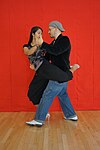 |
Wrap or caress by follower's leg raised up high and touching the partner's waist or legs | (https://en.wikipedia.org/wiki/Figures_of_Argentine_tango ) Bild: (Piotr Cirrus, 2011, Wikimedia) © CC BY-SA 3.0 |
25. Pivot
| spanisch | deutsch | englisch | Definition | Bild | Quelle |
|---|---|---|---|---|---|
| Calesita (f) | Karussell | carousel, merry-go-round | PONS: spanisch - deutsch, SpanishDict | ||
| Calesita | Carousel | Carousel; the merry-go-round: A figure in which the man places the lady on one foot with a lifting action of his frame and then dances around her while keeping her centered over, and pivoting on, her supporting leg. Sometimes referred to as the Stork when the lady’s leg is lifted in the cuatro position. | (http://www.tejastango.com/terminology.html ) | ||
| Calesita | Carousel | Circular movement in which the leader pivots the follower around. | (https://en.wikipedia.org/wiki/Figures_of_Argentine_tango ) | ||
| Planeo (m) | Gleitflug | gliding | PONS: spanisch - deutsch, SpanishDict | ||
| Planeo | Planeo | Pivoting on one leg with the other leg stretched out. |  |
(https://en.wikipedia.org/wiki/Figures_of_Argentine_tango ) Bild: (Piotr Cirrus, 2011, Wikimedia) © CC BY-SA 3.0 |
26. Pose
| spanisch | deutsch | englisch | Bild | Definition | Quelle |
|---|---|---|---|---|---|
| Corte | Cut: In tango, corte means cutting the music either by syncopating, or by holding for several beats. May refer to a position in which the torso is erect over a flexed supporting leg with the working leg extended forward to a pointe with the knees together which the man assumes when touching the lady’s foot with his in parada. The lady moves to the same position from parada as the man closes over her working foot in mordida, and pivots on her supporting foot in this position whenever the man leads an outside barrida. May also refer to a variety of dramatic poses featuring erect posture, flexed supporting legs, and extended dance lines by both dancers, used as a finale. See Cuartas. | (http://www.tejastango.com/terminology.html ) | |||
| Cuartas | Poses: Dance lines struck and held as dramatic flourishes at the end of a song. Large dramatic ones are used for stage or fantasia dancing, smaller softer versions occasionally in Salon style, and not used in Milonguero style at all. See Corte. | (http://www.tejastango.com/terminology.html ) | |||
| Open legs |  |
Dramatic final ending figure of tango with the follower's open legs. | (https://en.wikipedia.org/wiki/Figures_of_Argentine_tango ) Bild: (Piotr Cirrus, 2011, Wikimedia) © CC BY-SA 3.0 |
||
| Corte | Bow (break, cut, stop) |  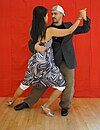 |
Bow or break in the movements. Corte has also meaning of tango with embellishments as opposed to tango without them (see quebrada). | (https://en.wikipedia.org/wiki/Figures_of_Argentine_tango ) Bild 1: (Piotr Cirrus, 2011, Wikimedia) © CC BY-SA 3.0 Bild 2: (Piotr Cirrus, 2011, Wikimedia) © CC BY-SA 3.0 |
28. Promenade
| spanisch | deutsch | englisch | Bild | Definition | Quelle |
|---|---|---|---|---|---|
| Americana | Promenade (sweetheart walk) |  |
Walking by facing the same direction and stepping forward. This resembles a walk in the park by sweethearts (except they may hold their hands together whereas in tango the embrace is preserved). This walk can be initiated by salida Americana. | (https://en.wikipedia.org/wiki/Figures_of_Argentine_tango ) Bild: (Piotr Cirrus, 2011, Wikimedia) © CC BY-SA 3.0 |
29. Pulpeada [see also Engache, Gancho, Piernazo]
| spanisch | deutsch | englisch | Bild | Definition | Quelle |
|---|---|---|---|---|---|
| el pulpo (m noun) | Krake | octopus | Leo, SpanishDict | ||
| Pulpeadas | Leg entanglements "sticky sacadas" | Class of trapped sacadas, wrapped sacadas, and carried (sp. llevada) ganchos. Named after Norberto Esbrez. | (https://en.wikipedia.org/wiki/Figures_of_Argentine_tango ) |
32. Sacada
| spanisch | deutsch | englisch | Bild | Definition | Quelle |
|---|---|---|---|---|---|
| Desplazamiento | Displacement: Displacing the partner’s leg or foot using one’s own leg or foot. See Sacada. | (http://www.tejastango.com/terminology.html ) | |||
| Entrada | Entrance: Occurs when a dancer steps forward or otherwise enters the space between their partners legs without displacement. | (http://www.tejastango.com/terminology.html ) | |||
| Pulpeadas | Leg entanglements "sticky sacadas" | Class of trapped sacadas, wrapped sacadas, and carried (sp. llevada) ganchos. Named after Norberto Esbrez. | (https://en.wikipedia.org/wiki/Figures_of_Argentine_tango ) | ||
| Sacada | The most common term for a displacement of a leg or foot by the partner’s leg or foot. Occurs when a dancer places their foot or leg against a leg of their partner and transfers weight to their leg so that it moves into the space of and displaces the partner’s leg. See Desplazamiento. | (http://www.tejastango.com/terminology.html ) | |||
| Sacada (entrada) | Shallow sacada (sacada, insert) |  |
Leader's leg replaces partner's unweighted leg position. Entrada doesn't influence movement of the follower's leg. This movement is called entrada or sacada in Spanish depending on instructor. | (https://en.wikipedia.org/wiki/Figures_of_Argentine_tango ) Bild: (Piotr Cirrus, 2011, Wikimedia) © CC BY-SA 3.0 |
|
| Sacada (quite) | Deep sacada (sacada) |  |
Displacement of partner's unweighted leg. | (https://en.wikipedia.org/wiki/Figures_of_Argentine_tango ) Bild: (Piotr Cirrus, 2011, Wikimedia) © CC BY-SA 3.0 |
|
| Sacada | Back sacada |  |
Displacement of partner's unweighted leg. | (https://en.wikipedia.org/wiki/Figures_of_Argentine_tango ) Bild: (Piotr Cirrus, 2011, Wikimedia) © CC BY-SA 3.0 |
33. Sandwich
| spanisch | deutsch | englisch | Bild | Definition | Quelle |
|---|---|---|---|---|---|
| Mordida | From morder: to bite; the little bite: One partner’s foot is sandwiched or trapped between the other partner’s feet. If the other partner’s feet are also crossed it may be referred to as Reverse Mordida. Sometimes called Sandwiche or Sanguchito. | (http://www.tejastango.com/terminology.html ) | |||
| Mordida Alto | A variation of mordida in which a dancer catches a partners knee between both of their own. | (http://www.tejastango.com/terminology.html ) | |||
| Sandwiche | See Mordida. | (http://www.tejastango.com/terminology.html ) | |||
| Sanguchito | See Mordida. | (http://www.tejastango.com/terminology.html ) | |||
| Mordida (sandwich, sanguche, sanguchito) | Sandwich | 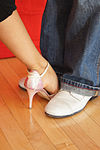 |
The leader places both feet on either side of the follow foot | (https://en.wikipedia.org/wiki/Figures_of_Argentine_tango ) Bild: (Piotr Cirrus, 2011, Wikimedia) © CC BY-SA 3.0 |
41. Volcada
| spanisch | deutsch | englisch | Bild | Definition | Quelle |
|---|---|---|---|---|---|
| Volcada | from Volcar - to tip-over or capsize; a falling step: The leader causes the follower to tilt or lean forward and fall off her axis before he catches her again. The process produces a beautiful leg drop from her. The movement requires the support of a close embrace. | (http://www.tejastango.com/terminology.html ) | |||
| Carpa, Apile, Apilado, Volcada | Apile (volcada) | 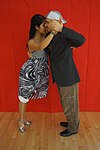 |
(Off-axis) Position in which both partners are leaning forward, may vary in degree of the tilt or shape. Many fluid and elegant tango figures can be danced in volcada position. | (https://en.wikipedia.org/wiki/Figures_of_Argentine_tango ) Bild: (Piotr Cirrus, 2011, Wikimedia) © CC BY-SA 3.0 |
|
| Volcada | Volcada |   |
Off-axis move in which the woman leans forward and does forward or back cross or decorative figures with her legs. Volcadas can be done in open and close embrace. In case of closed embrace she is supported by the leader's torso. In open embrace the leader's arm provides support for the suspension. See also apile. | (https://en.wikipedia.org/wiki/Figures_of_Argentine_tango ) Bild 1: (Piotr Cirrus, 2011, Wikimedia) © CC BY-SA 3.0 Bild 2: (Piotr Cirrus, 2011, Wikimedia) © CC BY-SA 3.0 |
|
| Volcada (suspended) |  |
Off-axis move in which the woman leans forward and her legs are opened and extended. | (https://en.wikipedia.org/wiki/Figures_of_Argentine_tango ) Bild: (Piotr Cirrus, 2011, Wikimedia) © CC BY-SA 3.0 |
||
| Volcada con adorno | Side volcada |  |
Off-axis move in which the woman leans forward to the man's side. She can do decorations with her leg. | (https://en.wikipedia.org/wiki/Figures_of_Argentine_tango ) Bild: (Piotr Cirrus, 2011, Wikimedia) © CC BY-SA 3.0 |
|
| Volcada | "Armpit" volcada |  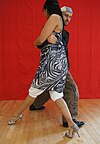 |
Off-axis move in which the woman leans forward to the man's side. | (https://en.wikipedia.org/wiki/Figures_of_Argentine_tango ) Bild 1: (Piotr Cirrus, 2011, Wikimedia) © CC BY-SA 3.0 Bild 2: (Piotr Cirrus, 2011, Wikimedia) © CC BY-SA 3.0 |





































































































































































































































































































































































































































































































































































































































































































































